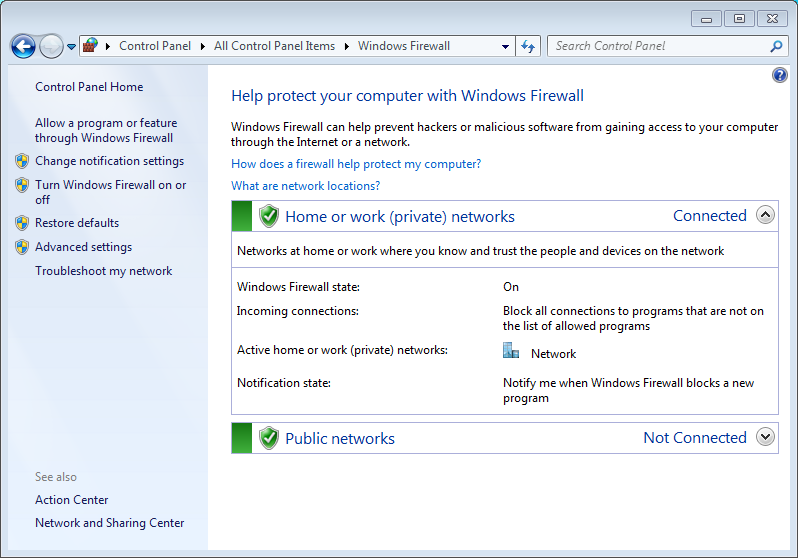
This article is about ways to protect your PC from viruses that can screw up your computer, or allow criminals to steal your data, personal information, or money.


Turn off the Windows firewall in Windows 7. Follow these steps to disable the built-in firewall: Open the start menu, and type 'firewall' in the search field; then, click on the 'Windows Firewall' link displayed in the search results, under Control Panel.

Use an antimalware app - Installing an antimalware app and keeping it up to date can help defend your PC against viruses and other malware (malicious software). Antimalware apps scan for viruses, spyware, and other malware trying to get into your email, operating system, or files. New threats can appear daily, so check the antimalware manufacturer's website frequently for updates.
Microsoft Defender is free antimalware software included with Windows, and you can update it automatically through Windows Update. There are also 3rd party antivirus products that you can choose from.More isn't always better
Running multiple antimalware apps at the same time can cause your system to be slow or unstable. If you install a 3rd party antimalware app, Microsoft Defender will automatically turn itself off. If you install two 3rd party antimalware apps, however, they might both try to run at the same time.
Don't open email messages from unfamiliar senders, or email attachments that you don't recognize - Many viruses are attached to email messages and will spread as soon as you open the attachment. It's best not to open any attachment unless it's something you're expecting. For more information see: Protect yourself from phishing.
Use a pop-up blocker with your Internet browser - Pop-up windows are small browser windows that appear on top of the website you're viewing. Although most are created by advertisers, they can also contain malicious or unsafe code. A pop-up blocker can prevent some or all of these windows from appearing. The pop-up blocker in Microsoft Edge is turned on by default.
If you're using Microsoft Edge, make sure SmartScreen is turned on - SmartScreen in Microsoft Edge helps protect you from phishing and malware attacks by warning you if a website or download location has been reported as unsafe. For more info, see What is SmartScreen and how can it help protect me?
Pay attention to Windows SmartScreen notifications - Be cautious about running unrecognized apps downloaded from the Internet. Unrecognized apps are more likely to be unsafe. When you download and run an app from the Internet, SmartScreen uses info about the app's reputation to warn you if the app isn't well-known and might be malicious.
Keep Windows updated - Periodically, Microsoft releases special security updates that can help protect your PC. These updates can help prevent viruses and other malware attacks by closing possible security holes.
You can turn on Windows Update to make sure that Windows receives these updates automatically.Use a firewall - Windows Firewall, or any other firewall app, can help notify you about suspicious activity if a virus or worm tries to connect to your PC. It can also block viruses, worms, and attackers sending potentially harmful apps to your PC.
Use your Internet browser's privacy settings - Some websites might try to use your personal info for targeted advertising, fraud, and identity theft.
Make sure User Account Control (UAC) is turned on - When changes are going to be made to your PC that require administrator-level permission, UAC notifies you and gives you the chance to approve the change. UAC can help keep viruses from making unwanted changes. To open UAC, swipe in from the right edge of the screen, and then tap Search. (If you're using a mouse, point to the upper-right corner of the screen, move the mouse pointer down, and then click Search.) Enter uac in the search box, and then tap or click Change User Account Control settings.
Clear your Internet cache and your browsing history - Most browsers store info about the websites you visit and the info that you provide, like your name and address. While it can be helpful to have these details stored on your PC, there are times when you might want to delete some or all of them—for example, when you're using a public PC and don't want to leave personal info behind. For more info, see Delete your browsing history.
Turn Off Firewall Vista
Figure 6: Windows settings App/Windows Security/Firewall Protection/Network Type. Figure 7: Legacy firewall.cpl. By default, the Windows Defender Firewall will block everything unless there is an exception rule created. This setting overrides the exceptions. For example, the Remote Desktop feature automatically creates firewall rules when enabled. Open Windows Firewall from Control Panel and click Turn Windows Firewall On Or Off. Then select Turn Off Windows Firewall (Not Recommended) for each firewall profile for which you want to disable the firewall. Open the Windows Firewall with Advanced Security snap-in. Figure 6: Windows settings App/Windows Security/Firewall Protection/Network Type. Figure 7: Legacy firewall.cpl. By default, the Windows Defender Firewall will block everything unless there is an exception rule created. This setting overrides the exceptions. For example, the Remote Desktop feature automatically creates firewall rules when enabled.
